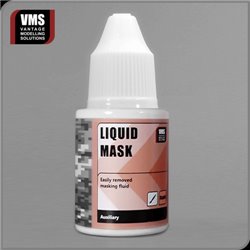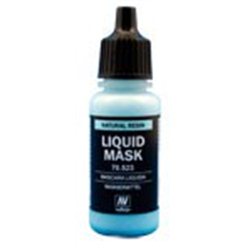Static grass puffer bottles work by manually charging model grass fibres with static electricity. When the charged...
No products
Product successfully added to your shopping cart
There are 0 items in your cart. There is 1 item in your cart.
Search Tips
What is a liquid mask and how do they work?
Liquid Masks are latex-based liquid masking solutions, generally supplied in a small bottle. They are a viable and practical alternative to masking tape for masking tricky items. They are generally cheap and if used with prudence a single bottle can be sufficient for a large number of modelling projects which makes them a versatile and practical addition to any modeller's toolbox.
Masking tape has always been a very useful technique for masking off areas during painting and works well, especially when there is a requirement for straight lines or masking off large areas. Masking tape is less effective in masking awkward or irregular surfaces, such as vehicle tyres or surface protrusions. Additionally, it may be awkward to mask off cockpit canopies or other clear parts as the masking tape inevitably has to be cut to fit which can be tricky and time-consuming.
Liquid Masks are ideally used as a counterpart to masking tape in those difficult-to-cover areas. Being liquid they can easily be applied with a brush and being latex-based they ideally sit on top of a painted surface without disturbing it. Liquid mask is quick-drying, generally in the order of 15-30 minutes. Additionally, as they dry they generally go translucent, thus giving the modeller a quick visual indication that it has set and that it is now ok to apply subsequent paint layers. As a general rule, Liquid Mask should not be left on the surface of a model for long periods, so it is good practice to remove it within 24 hours of application.
Liquid Mask can also be used as part of a weathering process. When applied in an irregular manner, such as flicking a brush with a toothpick or from a torn section of a scoring pad it can selectively cover an underlying substrate such as primer or rust. After the application of a topcoat, the mask can then be removed to reveal the underlying layer. This can be highly effective, especially when used with other weathering techniques such as washes or weathering powders.
In summary, Liquid Masks are not intended to be used as an alternative to masking tape but rather as a complementary method ideal for the masking of awkward or irregular surfaces. This allows the modeller the flexibility of deciding which particular technique is best suited to any given situation. A number of manufacturers supply Liquid Masking solutions, including Vallejo and Vantage Modelling Solutions (VMS).
Click here to receive the tips weekly in your mailbox. You can unsubscribe at any time.










